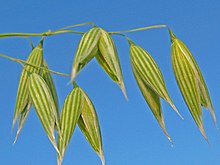Vavilovian mimicry

In plant biology, Vavilovian mimicry (also crop mimicry or weed mimicry
Vavilovian mimicry is a good illustration of unintentional
Classification and comparisons
Vavilovian mimicry can be classified as reproductive,
Delbert Wiens has argued that secondary crops cannot be classified as mimics, because they result from artificial as opposed to natural selection, and because the selective agent is a machine.[3] On this first point, Georges Pasteur points out that "indirect artificial selection" is involuntary and thus no different from natural selection.[2] That the signal receiver is an inanimate object certainly deviates from the normal case of a dupe perceiving the signal, but the result is no different from that of manual selection that has been occurring since the Neolithic Revolution.
Examples

One case of Vavilovian mimicry is the

Another example is
Rye is a hardier plant than wheat, surviving in harsher conditions. Having become
This fate is shared by
The flax-dodder (Cuscuta epilinum) is a creeper that grows around flax and linseed plants. Much like the other cases, its seeds have become larger. A mutant double-seeded variety has become prevalent, as seed size has once again been the character upon which selection has acted.[4]
Selection can also occur on the vegetative stage, through hand weeding. Weeding often takes place when the crop plant is very young, and most vulnerable. Echinochloa oryzoides, a species of grass which is found as a weed in rice (Oryza sativa) fields, looks similar to rice and its seeds are often mixed in rice and difficult to separate. This close similarity was enhanced by the weeding process which is a selective force that increases the similarity of the weed in each subsequent generation.[6]
See also
Notes
- ^ In this case the weed is the mimic, not the model as in ant mimicry.
References
- ^ Maran, Timo. "Mimicry". In Bouissac, Paul; Lewis, Ann; Lynch, Alejandro (eds.). Semiotics Encyclopedia Online. E. J. Pratt Library, Victoria College, University of Toronto. Retrieved 2007-10-19.
- ^ .
- ^ Wiens, D. (1978). "Mimicry in plants". Evolutionary Biology. 11: 365–403.
- ^ ISBN 0-07-070100-8.
- S2CID 86549764.
- ^ Barrett, S. (1983). "Mimicry in Plants". Scientific American. No. 257. pp. 76–83.
Sources
- Barrett, S. (1983). "Crop Mimicry in Weeds". Economic Botany. 37 (3): 255–282. S2CID 33048581. One of the most extensive articles on the topic.
- Wiens, D. (1978). "Mimicry in Plants". Evolutionary Biology. 11: 365–403. Discussion of crop mimicry among many other plant cases.
- Barrett, S. (1983). "Mimicry in Plants". Scientific American. No. 257. pp. 76–83. A significant portion discusses weeds.
- Radosevich, S. R.; Holt, J. S.; Ghersa, C. (1997). Weed Ecology: Implications for Management (2nd ed.). Wiley. ISBN 0-471-11606-8.
Further reading
- Vavilov, N. I. (1951). "The origin, variation, immunity and breeding of cultivated plants". Chronica Botanica. 13 (6). Translated by K. S. Chester: 1–366. .
- Vavilov, Nickolay Ivanovich; Löve, Doris, trans. (1992). Origin and Geography of Cultivated Plants. Cambridge, England, UK: Cambridge University Press.
{{cite book}}: CS1 maint: multiple names: authors list (link)

